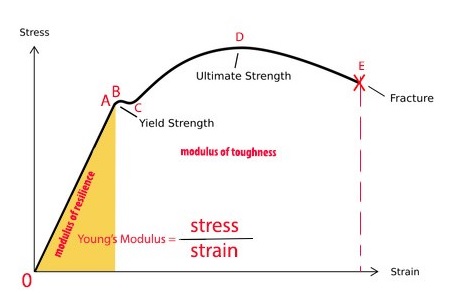Nervoustrig,
Right. So on the graph you provided my worry occurs between the upper yield point B and lower yield point C, where elastic distortion turns to plastic distortion. My understanding is once the crystal bonds begin to break the stress needed for their motion drops abruptly and plastic distortion can occur quickly in mild steel. I feared that at some point while turning the nut and adding another 0.05 inches of deflection in the barrel would suddenly result in 0.1 inches of permanent plastic distortion.
My situation is I purchased a used break barrel I knew nothing about. The POI is high which led me to believe maybe the barrel had been allowed to snap shut at some time, but laying the barrel along a straight edge there is no indication of a bend unless it is at the barrel/block junction and I cannot see it. It could be my imagination, but visually it almost appears the bore is not straight.
In any case, the safest solution is probably a droop mount installed backwards with the recoil arresting pin relocated into a new hole drilled in the other end of the mount.
It amazes me that anyone can bend a barrel an appropriate amount using the crotch of a tree or car bumper, lol!
ChrisK
You're issue was that you made the elaborate fixture to bend it, and you couldn't feel it move. Also you were putting all the force in one spot, right where the eye bolt was.
And the barrel may be straight to within .0015" and the issue with the angle of the breech block in relation to the barrel.
I don't know how you put "OK I can feel it give a little now" in a graph, but that's usually "just right" for the first adjustment LOL
I put the breech block in a big-ass bench vise, and pull on the muzzle end. You can feel when the flex stops, and the barrel "bends". Also I like to think that the bend isn't centralized in one spot this way.
As for weakening the steel I can't see how that's even a feasible concern. I took my brand new HW50S out of the box, handed it to my dad, and he immediately let the barrel slip and it slammed shut bending the barrel skyward. Looked absolutely ruined. I took it apart, bent it back, and it's the most accurate breakbarrel I've owned and it's been shot many thousand times with no change. Again, not scientific with a graph, but I think that's about as "worst-case" as it gets in real life.
I've done breakbarrels and underlevers and never had one shoot anything but better afterwards. I've even done three FWB300 actions.
Either way, just pull the barrel off, put the breech in a vise or under a car tire or whatever, and pull it till it points where you want it to go and life will be grand.

